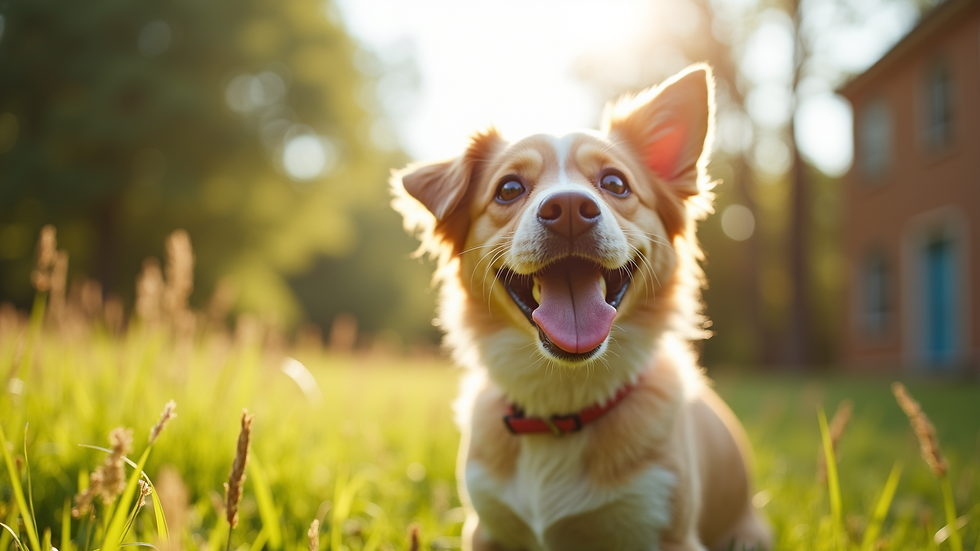Ensuring Your Pet's Safety in Extreme Heat: Essential Tips for Summer Care
- Arsalan Nazar
- Aug 21
- 5 min read
Updated: Sep 1
As the summer sun blazes down, it’s not just humans who need to take precautions against the heat. Our beloved pets are equally vulnerable to the dangers of high temperatures. Understanding how to keep your pet safe during summer heat is crucial for their health and well-being. This blog post will provide essential tips and insights to help you protect your furry friends from the sweltering summer heat.
Understanding the Risks of Heat Exposure
Pets, especially dogs and cats, can suffer from heat-related illnesses just like humans. They can’t cool themselves down as efficiently, making them more susceptible to heat exhaustion and heat stroke. According to the American Kennel Club, around 10,000 pets die each year due to heat-related illnesses.
Heat exhaustion occurs when a pet becomes overheated and shows signs of distress, such as excessive panting, drooling, weakness, or confusion. If not addressed promptly, it can escalate to heat stroke, a life-threatening condition that requires immediate veterinary attention.
Signs of Heat Stress in Pets
Recognizing the signs of heat stress in your pet is vital. Here are some common symptoms to watch for:
Excessive Panting: While panting is normal, excessive panting can indicate overheating. For instance, if your dog is panting heavily after just a few minutes of walking, it’s time to take action.
Drooling: Increased drooling or thick saliva can be a sign of distress. Keep an eye out for this symptom, especially in breeds like Bulldogs or Pugs, who are more prone to overheating.
Weakness or Lethargy: If your pet seems unusually tired or weak after engaging in normal activities, they may be struggling with the heat.
Rapid Heart Rate: An elevated heart rate can indicate that your pet is overheating. You can check this by gently placing your hand on their chest.
Vomiting or Diarrhea: Gastrointestinal distress can occur in severe cases of heat stress. If your pet shows this symptom, it may be a sign to seek veterinary help immediately.
If you notice any of these symptoms, it’s essential to take immediate action to cool your pet down.
Keeping Your Pet Cool
Provide Plenty of Fresh Water
One of the simplest yet most effective ways to keep your pet safe during summer heat is to ensure they have access to fresh, cool water at all times. Hydration is key to helping your pet regulate their body temperature. According to vets, pets should drink about 1 ounce of water per pound of body weight daily.
Make sure to refill their water bowl regularly, especially if they are spending time outdoors. Consider adding ice cubes to their water for an extra refreshing treat.

Create a Cool Environment
If your pet spends time indoors, ensure that your home is a comfortable temperature. Use fans or air conditioning to keep the environment cool. Studies show that even a fan can lower the perceived temperature by several degrees.
Provide a designated cool area where your pet can retreat when they feel too warm. This could be a shaded spot in your yard or a cozy corner in your home with a fan. Remember to check that the space is free from heat traps, like direct sunlight or closed windows.
Limit Outdoor Activities
During the hottest parts of the day, it’s best to limit outdoor activities. Early morning or late evening walks are ideal when temperatures typically drop below 80°F (27°C).
If your pet enjoys playing outside, consider providing shaded areas and taking frequent breaks to ensure they don’t overheat. A study found that dogs are more at risk when temperatures exceed 85°F (29°C).
Grooming for Summer
Regular Grooming
Regular grooming is essential for your pet’s comfort during the summer months. For dogs with thick fur, consider a summer haircut to help them stay cool. For example, breeds like Golden Retrievers can benefit from a trim to minimize heat retention.
Brushing your pet regularly can also help remove excess fur and prevent matting, which can trap heat. Try to groom your pets at least once a week.
Bathing
Giving your pet a cool bath can be a great way to help them cool down. Use lukewarm water, as cold water can cause shock. Regular baths can also remove dirt and loose fur that contribute to overheating.
After bathing, ensure your pet is dried properly, especially if they have long fur, to prevent them from getting chilled.
Safe Outdoor Practices
Avoid Hot Pavement
Hot pavement can burn your pet’s paws and lead to discomfort. The asphalt temperature can be 30% hotter than the air temperature. To test the pavement, place your hand on the ground for seven seconds. If it’s too hot for you, it’s too hot for your pet.
Consider using pet booties to protect their paws or stick to grassy areas for walks.
Provide Shade
If your pet spends time outdoors, ensure they have access to shaded areas. Trees, umbrellas, or pet tents can provide relief from the sun. A study found that shaded areas can reduce surface temperatures by over 20°F (11°C).
Never Leave Pets in a Car
Leaving pets in a parked car, even for a few minutes, can be deadly. The temperature inside a car can rise rapidly. For example, on a 70°F (21°C) day, the inside of a car can reach 100°F (38°C) in just 20 minutes. Always take your pet with you or leave them at home when running errands.

Nutrition and Summer Care
Adjusting Diet
During the summer, your pet’s dietary needs may change. Consider providing lighter meals that are easier to digest. For pet owners, this can mean choosing wet food or adding more fruits and vegetables.
Fresh fruits and vegetables can be a great addition to their diet, but ensure they are safe for pets. For instance, watermelon is safe and hydrating for dogs, while grapes are toxic. Always consult your veterinarian before making significant changes to your pet’s diet.
Treats for Cooling Down
Frozen treats can be a fun way to help your pet cool down. You can freeze low-sodium broth in ice cube trays or create pet-friendly popsicles using yogurt and blueberries. These treats serve as delicious hydration boosts.
Emergency Preparedness
Know What to Do in an Emergency
In case your pet shows signs of heat stress, it’s crucial to know how to respond. Move them to a cooler area immediately and offer them water.
You can also use cool, wet cloths to help lower their body temperature. Place them on areas like their paws or underbelly. If symptoms persist, seek veterinary care as soon as possible.
Keep Emergency Contacts Handy
Have your veterinarian’s contact information readily accessible, along with the nearest emergency animal clinic. Being prepared can make a significant difference in a crisis.
Final Thoughts
Keeping your pet safe during the summer heat requires vigilance and proactive measures. By providing plenty of water, creating a cool environment, and being mindful of outdoor activities, you can help ensure your furry friend stays comfortable and healthy throughout the hot months.
Remember, your pet relies on you to keep them safe, so take the necessary steps to protect them from the dangers of extreme heat. With a little care and attention, you can enjoy a fun and safe summer with your beloved pet.





Comments